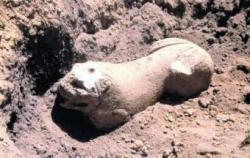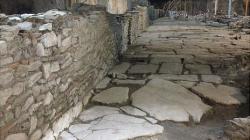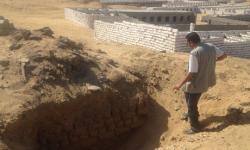INSTITUT SUPERIEUR D'ANTHROPOLOGIE
INSTITUTE OF ANTHROPOLOGY
ONLINE COURSES / COURS A DISTANCE
SPRING SESSION : APRIL 2013
REGISTER NOW
FRANCE –  Warmeriville - Vincent Marchesseau, responsable de la campagne de fouilles sur le site de la Bassière, à Warmeriville, ne boude pas son plaisir. Lui et son équipe d'archéologues vont, depuis un mois, maintenant de découvertes en découvertes. L'année passée, ces mêmes archéologues avaient découvert sur un peu plus d'un hectare de terrains, des dizaines d'implantations humaines ainsi que de nombreux espaces de pacquages et d'élevage. « La zone que nous fouillons actuellement est encore plus riche que celle de l'année passée. On retrouve des « fonds de cabanes » mais aussi des implantations d'habitations en pierre. Ce qui est le plus intéressant ici, c'est la taille de l'emprise où des hommes ont vécu, ont élevé du bétail durant plusieurs siècles » continue le spécialiste. En effet, les datations effectuées sur le site montrent que les occupations du site sont comprises, pour la majeure partie entre les Ve et IXe. « On a vraiment affaire au proto-village de Warmeriville, qui, par la suite, s'est retrouvé implanté de l'autre côté de la rivière Suippe. Nous retrouvons des aires de pacquage pour le bétail, des zones de stockages. Illustration que cette zone était dédiée à l'élevage dans sa partie basse (vers le cours de la Suippe) avec des centaines d'ossements d''animaux retrouvés. On retrouve le triptyque de l'élevage de cette époque avec des ovins, des porcs mais également des bovidés. Nous pensons même que nous avons mis en évidence l'existence d'une sorte de stabulation où plusieurs bêtes étaient rassemblées sur une zone restreinte ». La seconde campagne de fouilles, le long de la RD 20, sur le futur lotissement de la Bassière devrait continuer encore plusieurs semaines.
Warmeriville - Vincent Marchesseau, responsable de la campagne de fouilles sur le site de la Bassière, à Warmeriville, ne boude pas son plaisir. Lui et son équipe d'archéologues vont, depuis un mois, maintenant de découvertes en découvertes. L'année passée, ces mêmes archéologues avaient découvert sur un peu plus d'un hectare de terrains, des dizaines d'implantations humaines ainsi que de nombreux espaces de pacquages et d'élevage. « La zone que nous fouillons actuellement est encore plus riche que celle de l'année passée. On retrouve des « fonds de cabanes » mais aussi des implantations d'habitations en pierre. Ce qui est le plus intéressant ici, c'est la taille de l'emprise où des hommes ont vécu, ont élevé du bétail durant plusieurs siècles » continue le spécialiste. En effet, les datations effectuées sur le site montrent que les occupations du site sont comprises, pour la majeure partie entre les Ve et IXe. « On a vraiment affaire au proto-village de Warmeriville, qui, par la suite, s'est retrouvé implanté de l'autre côté de la rivière Suippe. Nous retrouvons des aires de pacquage pour le bétail, des zones de stockages. Illustration que cette zone était dédiée à l'élevage dans sa partie basse (vers le cours de la Suippe) avec des centaines d'ossements d''animaux retrouvés. On retrouve le triptyque de l'élevage de cette époque avec des ovins, des porcs mais également des bovidés. Nous pensons même que nous avons mis en évidence l'existence d'une sorte de stabulation où plusieurs bêtes étaient rassemblées sur une zone restreinte ». La seconde campagne de fouilles, le long de la RD 20, sur le futur lotissement de la Bassière devrait continuer encore plusieurs semaines.
http://www.lunion.presse.fr/article/culture-et-loisirs/fouilles-archeologiques-du-jamais-vu-depuis-dix-ans
ITALIE –  Banditaccia - Recent excavations at the necropolis of Banditaccia in Cerveteri have unearthed a statue of a lion and an Etruscan tomb. The statue of a crouching lion is made from volcanic tuff and dates to the 6th century BC. The piece is said to be in perfect condition, showing taut muscles and well-defined legs. The Cerveteri Lion is the first entire lion statue found at the site. It was found at the foot of what experts describe as an altar for funeral rites and was the “guardian” of an extraordinary tomb discovered only a few yards away. The newly discovered tomb is in the form of an underground rectangular chamber accessed by a monumental staircase. The chamber dates from the 4th to 3rd century BC. The chamber contained some 20 skeletons, of which seven are well preserved. The tomb also contained 10 stones complete with inscriptions, along with a treasure trove of ceramic and bronze funereal objects. The main burial area belonged to an adult woman and contained the remains of wicker baskets, along with fragments of wool and flax. Experts believe the tomb belonged to a noble family and that the woman was a prestigious figure in her clan. The Etruscans lived in west-central Italy from the 9th century BC onwards and Etruscan culture reached its height in the 6th century BC. The Cerveteri necropolis in Lazio, Rome developed from the 9th century BC. It contains thousands of tombs that replicate Etruscan town-planning schemes, with streets, squares and neighbourhoods. The tombs vary in kind according to when they were built and family status. Some are tumuli, some trenches cut in rock and other form the shape of houses.
Banditaccia - Recent excavations at the necropolis of Banditaccia in Cerveteri have unearthed a statue of a lion and an Etruscan tomb. The statue of a crouching lion is made from volcanic tuff and dates to the 6th century BC. The piece is said to be in perfect condition, showing taut muscles and well-defined legs. The Cerveteri Lion is the first entire lion statue found at the site. It was found at the foot of what experts describe as an altar for funeral rites and was the “guardian” of an extraordinary tomb discovered only a few yards away. The newly discovered tomb is in the form of an underground rectangular chamber accessed by a monumental staircase. The chamber dates from the 4th to 3rd century BC. The chamber contained some 20 skeletons, of which seven are well preserved. The tomb also contained 10 stones complete with inscriptions, along with a treasure trove of ceramic and bronze funereal objects. The main burial area belonged to an adult woman and contained the remains of wicker baskets, along with fragments of wool and flax. Experts believe the tomb belonged to a noble family and that the woman was a prestigious figure in her clan. The Etruscans lived in west-central Italy from the 9th century BC onwards and Etruscan culture reached its height in the 6th century BC. The Cerveteri necropolis in Lazio, Rome developed from the 9th century BC. It contains thousands of tombs that replicate Etruscan town-planning schemes, with streets, squares and neighbourhoods. The tombs vary in kind according to when they were built and family status. Some are tumuli, some trenches cut in rock and other form the shape of houses.
http://www.italymag.co.uk/italy/etruscan-tomb/lion-statue-and-etruscan-tomb-discovered-cerveteri
GRECE –  Thessalonique - Archaeologists in Greece's northern metropolis Thessaloniki were already overjoyed in 2006 when a 2,300-year-old avenue was found during construction work on the city's new underground rail network. The rescue excavation has unearthed significant evidence of the city's urban life between the fourth and nine centuries AD, five metres beneath the city's modern highway. In addition to a 76-metre (83-yard) stretch of marble avenue (decumanus) originally paved in the third century BC that led to the harbour, there is a monumental Roman-style gate and the remains of public buildings, offering a rare glimpse into social, commercial and daily life during the early Byzantine Empire. "This was a central crossroads where the city's central market and public buildings were located," said Despoina Koutsoumba, head of the association of Greek archaeologists. "The area has retained the same character today, it remains the heart of the city's society," she said. Several contemporary texts from lay and ecclesiastical authors specifically refer to this ancient avenue, known at the time as Thessaloniki's 'Middle road'. Bustling with merchants and travellers by day, by night it was given to religious processions of holy icons and relics, a common practise during the Byzantine era. Working ahead of the rail construction drills, archaeologists have recovered over 100,000 objects in the area, including over 50,000 coins. Vessels, lamps, vials and jewels of various types have also been found -- in keeping with the area's trading character -- in addition to 2,500 graves of Hellenistic and Roman times. A key Balkan port fought over by Greeks, Romans, Slavs and Turks for centuries, Thessaloniki was founded in the fourth century BC by king Cassander of Macedon, who named the city after his wife, the sister of Alexander the Great.
Thessalonique - Archaeologists in Greece's northern metropolis Thessaloniki were already overjoyed in 2006 when a 2,300-year-old avenue was found during construction work on the city's new underground rail network. The rescue excavation has unearthed significant evidence of the city's urban life between the fourth and nine centuries AD, five metres beneath the city's modern highway. In addition to a 76-metre (83-yard) stretch of marble avenue (decumanus) originally paved in the third century BC that led to the harbour, there is a monumental Roman-style gate and the remains of public buildings, offering a rare glimpse into social, commercial and daily life during the early Byzantine Empire. "This was a central crossroads where the city's central market and public buildings were located," said Despoina Koutsoumba, head of the association of Greek archaeologists. "The area has retained the same character today, it remains the heart of the city's society," she said. Several contemporary texts from lay and ecclesiastical authors specifically refer to this ancient avenue, known at the time as Thessaloniki's 'Middle road'. Bustling with merchants and travellers by day, by night it was given to religious processions of holy icons and relics, a common practise during the Byzantine era. Working ahead of the rail construction drills, archaeologists have recovered over 100,000 objects in the area, including over 50,000 coins. Vessels, lamps, vials and jewels of various types have also been found -- in keeping with the area's trading character -- in addition to 2,500 graves of Hellenistic and Roman times. A key Balkan port fought over by Greeks, Romans, Slavs and Turks for centuries, Thessaloniki was founded in the fourth century BC by king Cassander of Macedon, who named the city after his wife, the sister of Alexander the Great.
http://www.globalpost.com/dispatch/news/afp/130428/thessalonikis-pompeii-saved-relocation
EGYPTE –  Dahchour - In Manshiet Dahshur, 25 miles south of Cairo, the villagers recently extended the boundaries of the cemetery. There is just one problem. The new tombs are perilously close to some of Egypt's oldest: the pyramids of Dahshur, less famous than their larger cousins at Giza, but just as venerable. This is protected land, and no one is supposed to build here - yet more than 1,000 illegal tombs have appeared in the desert since January. The tombs nestle in the dunes below the Red Pyramid, considered the pharaohs' first successful attempt at a smooth-sided structure. To the south is the Bent Pyramid, named for its warped walls. In the east, nearer the Nile, lies the Black Pyramid - a collapsed colossus on which the villagers are most in danger of encroaching. "Dahshur is just a single case study of what's happening on every archaeological site in Egypt," said Monica Hanna, who campaigns for greater resources to be allocated to Egypt's ancient sites. "It's happened all around the Nile valley, in El Hiba, in Beni Suef. Everywhere."
Dahchour - In Manshiet Dahshur, 25 miles south of Cairo, the villagers recently extended the boundaries of the cemetery. There is just one problem. The new tombs are perilously close to some of Egypt's oldest: the pyramids of Dahshur, less famous than their larger cousins at Giza, but just as venerable. This is protected land, and no one is supposed to build here - yet more than 1,000 illegal tombs have appeared in the desert since January. The tombs nestle in the dunes below the Red Pyramid, considered the pharaohs' first successful attempt at a smooth-sided structure. To the south is the Bent Pyramid, named for its warped walls. In the east, nearer the Nile, lies the Black Pyramid - a collapsed colossus on which the villagers are most in danger of encroaching. "Dahshur is just a single case study of what's happening on every archaeological site in Egypt," said Monica Hanna, who campaigns for greater resources to be allocated to Egypt's ancient sites. "It's happened all around the Nile valley, in El Hiba, in Beni Suef. Everywhere."
http://www.guardian.co.uk/world/2013/apr/28/pyramid-tomb-dahshur-egypt-archaeology
ROYAUME UNI – Haverhill - Headland Archaeology is to present its findings to the public from an archaeological dig on the site of Haverhill Research Park. The dig was commissioned in the summer of 2012 by developer Carisbrooke Developments in order to ensure that the site’s history was understood and recorded before construction commenced after initial works identified prehistoric and Roman remains. Headland Archaeology will detail the occupation on the site from the late Iron Age through to the post-medieval period. Based on their findings, the area was used mainly for farming cattle, sheep and goats during the 2nd Century. Archaeologists also identified a small post-built Anglo Saxon Hall as well as a group of Saxon brooches and beads. Additionally, they found evidence that several of the Roman ditches survived through the Saxon period and Middle Ages into the 1840s when they were still used as field boundaries.
http://www.haverhillecho.co.uk/community/community-news/dig-findings-at-haverhill-research-park-to-be-revealed-1-5040768
TROMELIN -  Le 31 juillet 1761, l’Utile, une flûte appartenant à la Compagnie des Indes françaises orientales, fait naufrage à Tromelin. À son bord, l’équipage transporte une cargaison humaine de 80 esclaves achetés en fraude à Madagascar. Ils sont destinés à être vendus sur l’île de France (actuelle île Maurice). Certainement dévié par le mauvais temps et poussé par les lames sur les récifs, l’Utile est pris au piège de l’Île des Sables. Cette dernière se transforme en radeau de fortune pour les rescapés. Avec les débris du navire, ces derniers construisent un radeau. L’équipage s’embarque à bord promettant de revenir chercher les esclaves. Après plusieurs jours dans la tourmente maritime, l’équipage débarque à Madagascar. La promesse faite aux rescapés malgaches ne sera pas tenue. Ce n’est que le 29 novembre 1776 que le chevalier de Tromelin, commandant la corvette La Dauphine, récupère les survivants : sept femmes et un bébé de 8 mois. Quinze ans après le naufrage… Ils ont su faire face à des conditions extrêmes. Livrés à eux-mêmes, ils ont su recréer une société sur ce caillou abandonné de tous. Max Guérout et son équipe travaillent aujourd’hui à une quatrième campagne. Cette nouvelle expédition, prévue à compter du 22 août et pour 45 jours, vise essentiellement à découvrir les sépultures des esclaves malgaches morts aux cours de leur calvaire de quinze ans. Les vestiges ont parfois été recouverts par les bâtiments construits à partir des années cinquante in situ. Max Guérout a également tenté de retrouver les descendants des esclaves ramenés par le chevalier de Tromelin à Maurice. Affranchis, certains ont travaillé pour le compte du gouverneur et aucun n’est retourné à Madagascar.
Le 31 juillet 1761, l’Utile, une flûte appartenant à la Compagnie des Indes françaises orientales, fait naufrage à Tromelin. À son bord, l’équipage transporte une cargaison humaine de 80 esclaves achetés en fraude à Madagascar. Ils sont destinés à être vendus sur l’île de France (actuelle île Maurice). Certainement dévié par le mauvais temps et poussé par les lames sur les récifs, l’Utile est pris au piège de l’Île des Sables. Cette dernière se transforme en radeau de fortune pour les rescapés. Avec les débris du navire, ces derniers construisent un radeau. L’équipage s’embarque à bord promettant de revenir chercher les esclaves. Après plusieurs jours dans la tourmente maritime, l’équipage débarque à Madagascar. La promesse faite aux rescapés malgaches ne sera pas tenue. Ce n’est que le 29 novembre 1776 que le chevalier de Tromelin, commandant la corvette La Dauphine, récupère les survivants : sept femmes et un bébé de 8 mois. Quinze ans après le naufrage… Ils ont su faire face à des conditions extrêmes. Livrés à eux-mêmes, ils ont su recréer une société sur ce caillou abandonné de tous. Max Guérout et son équipe travaillent aujourd’hui à une quatrième campagne. Cette nouvelle expédition, prévue à compter du 22 août et pour 45 jours, vise essentiellement à découvrir les sépultures des esclaves malgaches morts aux cours de leur calvaire de quinze ans. Les vestiges ont parfois été recouverts par les bâtiments construits à partir des années cinquante in situ. Max Guérout a également tenté de retrouver les descendants des esclaves ramenés par le chevalier de Tromelin à Maurice. Affranchis, certains ont travaillé pour le compte du gouverneur et aucun n’est retourné à Madagascar.
http://www.clicanoo.re/366243-des-esclaves-oublies-pendant-quinze-ans.html